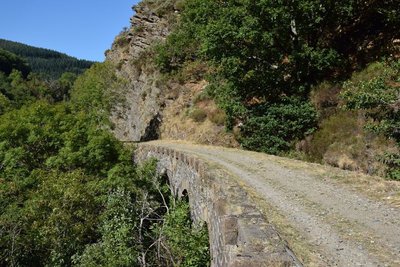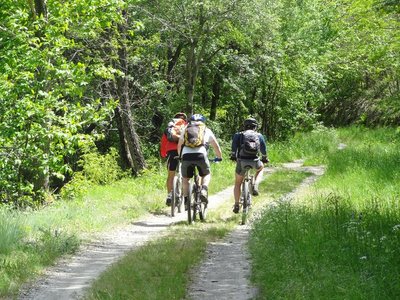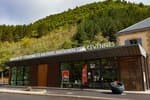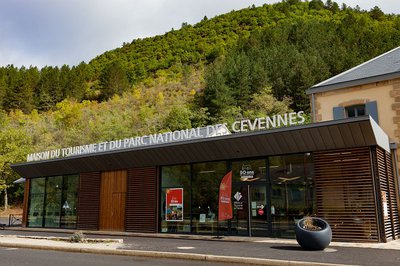
1. Discovering the Upper Cévennes (Day 1).
3 points of interest

Château de Saint-Julien-d'Arpaon - © com com Florac Sud Lozère  History
HistoryChâteau de Saint-Julien-d'Arpaon
This 13th century castle was the property of the Lords of Anduze, who owned the barony of Florac in what was then the Gévaudan. In 1618, when the Gabriac family owned it, the castle was demolished. In the 18th century, it was inherited by the Montcalm family from Rouergue province, which owned several properties in the Gévaudan. The family restored the building, but it has suffered from effects of time and is currently in ruins – though in a better state of preservation than other castles in the Gévaudan.

Pont sur le CéFéDé - © com com Florac Sud Lozère  History
HistoryThe CFD (mountain-bike route)
Users and employees still talk of the former railway (CFD) with regret and emotion:
“To go to Montpellier on Mondays, I could leave at 6 in the morning, and arrive in Montpellier at 10, and you could get back here in the evening. The train arrived at 10 o'clock in the evening. Now (with the coach), you can go down, but you have to wait for the next day to come back up. It was very useful. Nowadays, if you don't have a car, what do you do? You hitch-hike, you walk!” (P. Grime)
“Two years after the train was shut down, we had the idea of putting it back on the track and turning it into a tourist train. We managed to get a railcar to start... We hadn't told anyone: apparently we didn't have the right to do it, we even risked getting a correctional sentence. Nothing happened... Except that at St-Julien-des-Points we gave a blast of this kind of horn that we had, and M., from the restaurant, came up with a litre of pastis, and two or three farmers from the area arrived too. We all cried like babies. We had the impression that the heart of the area was beating again.” (Revue Cévennes, issue 15)
CFD - © Cévennes Evasion  History
HistoryThe disused railway (CéFéDé)
From 1909 to 1968, this railway line linked Florac and Sainte-Cécile-d'Andorge (50 km). A metre-gauge single-track line, it was managed by the department's railway company. It was linked to the SNCF state railway network. The trains transported passengers and merchandise: ore from Ramponenche mine near Florac; baryte from the mine at Jalcreste, and plums, chestnut wood, dried boletus mushrooms, etc., destined for northern France. As you move along the disused line, you will see former engineered constructions (bridges, tunnels, etc.).
Description
1 – You alternate between lanes and tracks for 7 km, before reaching the N106 road.
2 – Cross the road and walk towards Saint-Julien d'Arpaon, then go right onto the disused railway tracks for 4 km.
3 – Cross the road again and take, on your left, the path that runs alongside the river for 3 km until you reach the former train station at Cassagnas.
If you wish to go to the actual village of Cassagnas, you will have to walk uphill to above the RN106 (3 km).
- Departure : Florac
- Arrival : Cassagnas: former train station
- Towns crossed : Florac Trois Rivières, Cans et Cévennes, and Cassagnas
Forecast
Altimetric profile
Recommandations
Information desks
Tourism'house and national Parc at Florac
Place de l'ancienne gare, N106, 48400 Florac-trois-rivières
This office is part of the National Park's associated tourist-information network, whose mission is to provide information on, and raise awareness of, the sites and events as well as the rules that must be observed in the National Park's central zone.
On site: exhibitions, video projections, events and shop Open year-round
Transport
Bus line Florac-Mende
Daily from Monday to Saturday morning (except bank holidays) all year
https://lio.laregion.fr/IMG/pdf/oc-1903-fhbus-48-251-3v_bd_04_.pdf
Bus line Florac Ste-Enimie Le Rozier, July and August, every day
https://lio.laregion.fr/IMG/pdf/oc-1903-fhbus-48-258-3v_bd_04_.pdf
Bus line Alès-Florac (by reservation only if departing from Ispagnac) Boulet +33 (0)4 66 65 19 88
Daily bus line (except Sundays and bank holidays) from 15 April to 31 October.
https://fr.calameo.com/read/003034667db3a5b1c0788
Access and parking
Parking :
Calculateur d'itinéraire Lio
Utilisez le calculateur liO pour organiser votre trajet en région Occitanie.
Autres régions
Calculez votre itinéraire en Auvergne Rhône Alpes sur Oùra
Biodiversité autour de l'itinéraire
Source

Report a problem or an error
If you have found an error on this page or if you have noticed any problems during your hike, please report them to us here:


